Vestibular habituation. A new theory
Although it has already been over hundred years since Abels used the term "habituation" to explain a slow extinction of the seasickness symptoms, this phenomenon, despite numerous experimental and clinical works, still has not been properly explained (1, 2). The term "vestibular habituation" is used to define a temporary reduction of oculomotor and spinal reactions and subjective reactions to the repeated vestibular stimulation of a similar power and character. As soon as one labyrinth is damaged partially or entirely, the mechanisms in the central nervous system aiming at compensation of the tension between the damaged side and the unimpaired side are triggered. In the clinical practice it will mean a slow extinction of subjective and objective symptoms accompanying the destruction of the labyrinth. It was generally accepted (1) that it is the central nervous system, whose place is not well-known yet, which is responsible for production of vestibular habituation. The cerebellum can participate in these processes (Halstead, 1935; Halstead, Yacorzrzynski, Fearing, 1937), but it is likely that the reticulate formation and other structures can play the fundamental role. In 1959 Hernandez Paeon proposed a view that that the reticular formation of the brain stem plays the central role in habituation - quotation according to (5). However, Frenzel (6) and Fluur (7) claimed that habituation may appear when the vestibular system works asymmetrically: as a result of a peripheral or a central damage. It must also be mentioned that many explorers, based on numerous physiological and pharmacological experiments, claimed that habituation depended on the activity of the cerebral cortex (Bechterew 1881; Asratjan 1940; Kolbe 1955; Smith 1941; Zelenka 1960) - and on the activity of the brain stem (Kingas 1926; Sharpless and Jasper 1956; Palestini et al. 1959; Gernandt and Gilman 1960) - quotation according to (5). For many years it was thought that vestibular habituation could be produced using caloric or kinetic stimulation. It was claimed that the most favorable stimuli are situated within physiological stimulations (rather weak stimuli), of similar values and repeated at regular intervals. In order to cause vestibular habituation we need not use induced external stimuli. It will be sufficient that in paired vestibular organs appear a disequilibrium of the resting activity (3). I partly discussed the phenomenon of vestibular habituation during my presentation of kinetic and caloric tests. Now, based on fig. 1 I will explain in more detail the mechanism of the formation of this phenomenon.
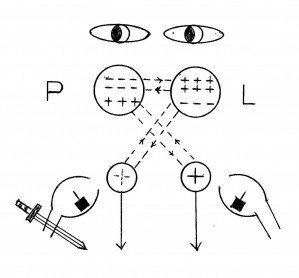
Fig.1
Fig 1. The mechanism of formation of vestibular habituation after the destruction of the right labyrinth.
After the entire destruction of the right labyrinth there will appear a violent disequilibrium in the closed vestibulocerebellar system. At rest we observe strong vertigo with nausea and vomiting, there will also appear spontaneous paralytic nystagmus towards the healthy labyrinth and other well-known and described symptoms. In order to suppress these undesirable symptoms, habituation starts in the equilibrium system from the moment of the destruction of the labyrinth. At first, during this sharp disequilibrium there is a decrease almost to zero in the activity of the vestibular nuclei complex on the right side. The quantitative cytochemical study by Blomstrand et al. quotation according to (8) showed a decrease in the quantity of the ribonucleic acid in Deiter's cells on the side of the damaged labyrinth and then its gradual growth and compensation within the period of balancing the tension between the damaged side and the unimpaired side. The constant resting activity from the left labyrinth is transmitted to the right cerebellar hemisphere, but nystagmus to the left, which arose at the beginning, now gradually diminishes. The organism defends itself against the unnecessary loss of energy during the formation of such nystagmus. In the right cerebellar hemisphere there are changes, the hemisphere which is constantly stimulated is gradually inhibited. Symbolically, in the right cerebellar hemisphere there arises a bigger number of negative signs and the subsequent stimuli coming from the left labyrinth are not capable of producing nystagmus to the left. According to the physiological activity of the cerebellar hemispheres and the vestibulocerebellar system, if the right cerebellar hemisphere was inhibited then the left cerebellar hemisphere was stimulated (the bigger number of the "plus" signs). The stimulated left cerebellar hemisphere begins to send impulses to the right vestibular nuclei complex, increasing its potential. In the complex of these nuclei a gradual growth of the resting bioelectric activity is observed. As a result of the formation of habituation the activity of both vestibular nuclei complexes differs from the state which occurred directly after the destruction and also from the correct state. In the case of the performed habituation with a partial destruction of the right labyrinth (fig. 1) we obtain the symmetrical directional predominance to the right, that is in the bicaloric test, after using a warm stimulus to the right ear and a cold stimulus to the left ear, we will receive longer nystagmus reactions to the right and weaker reactions to the left after using a cold stimulus to the right ear and a warm stimulus to the left ear. On the healthy side, while using the caloric stimulus with hot water, the excitability threshold is increased and on the side damaged it is decreased. The obtained habituation is characterized with peculiarity regarding the direction. A similar model can be obtained in a healthy person as a result of sequentially repeated caloric stimulations of the left ear with water with the temperature of 44°C, attaining a decrease in nystagmus to the left, induced in this way. However, the stimulation of the same ear with cold (30°C) water will trigger a nystagmus reaction to the right with a higher intensity, because the right cerebellar hemisphere was inhibited. If now use a cold stimulus (30°C) to the right ear, we will obtain a reduced reaction because the direction of the caused nystagmus (to the left) is compatible with the direction on which habituation was obtained. Specifically tt is associated with the fact that the cold stimulus applied to the right ear encounters the stimulated left cerebellar hemisphere, where it is inhibited. Therefore, it is not transferring habituation from ear to ear as it has been claimed until nowadays but it is connected with the processes of stimulating and inhibiting the cerebellar hemispheres. It is clearly visible here that the leading part in habituation is played by the labyrinths and the cerebellum. The cerebellum is the central organ of the equilibrium system. The fact hat these processes of habituation after the destruction of the labyrinth occur in the cerebellum and the brain stem, was evidenced by earlier research. Llinas and Walton (4), carrying out numerous studies on guinea pigs with 2-deoxyglucose marked with carbon C 14, found that during vestibular compensation there was an increase in the activity in the central nervous system, mainly in the cerebellum and the brain stem. This activity is connected with habituation and not with compensation. In order for habituation to be activated spontaneously there must appear asymmetry in the activity of the labyrinths (3). The habituation is a fundamental and the most important phenomenon in the equilibrium system which allows compensating in the vestibular nuclei complex the shortage which arose in the periphery after the destruction of one labyrinth. Because quite often, due to numerous reasons the labyrinth or the vestibular nerve might be damaged, the entire repair process takes place in the brain stem and the cerebellum, i.e. in better protected structures. Depending on the time which elapsed from the destruction of the peripheral section of the vestibular organ and the degree of formation of habituation, in the research into the vestibulocerebellar system we can receive various results, sometimes differing very much in the same person in short intervals. After the destruction of the right labyrinth spontaneous nystagmus to the left is recorded. In rotation tests also only nystagmus to the left is recorded. Using at the beginning a warm stimulus to the right ear and a cold stimulus to the left ear one cannot cause a nystagmus reaction in the opposite direction, i.e. to the right. From the very beginning of the destruction the habituation process begins and gradually after the warm stimulus to the right ear and the cold stimulus to the left ear a nystagmus reaction to the right begins to appear. In this period of time the bicaloric test reveals canal paresis on the right side and a real not crossed directional predominance to the left. Gradually on the right side the threshold of excitability to the warm stimulus is lowered and on the left side the threshold of excitability to the warm stimulus is raised. In the kinetic tests symmetrical responses are obtained after rotations to the right and left. Also, after the warm stimulus reactions from the right ear and left ear begin to balance out. Further habituation leads to spontaneous nystagmus and positional nystagmus to the right. In the bicaloric test we can obtain the symmetrical directional predominance to the right or the real crossed directional predominance to the right with canal paresis on the left side. After stimulating the left labyrinth with hot water no nystagmus reaction can be obtained. In kinetic tests we observe stronger nystagmus reactions to the right or entire unresponsiveness to the left. It is also worth mentioning that in the early period after the destruction of the right labyrinth, when in the right vestibular nuclei complex there was still no partial compensation of tension, after using the cold stimulus to the left ear we will receive only abduction to the left the left upper limb, the right one remaining still. When a state of constant stimulation is formed in the left cerebellar hemisphere and the tension between the damaged and the unimpaired side is balanced in the right vestibular nuclei complex, then the use of a cold stimulus to the left ear will trigger a nystagmus reaction to the right and a deviation of both upper limbs to the left. Based on the original picture No. 12, which was presented in my habilitation lecture, I will present the highlights of the research into the equilibrium system in an ill person with the destruction of the right labyrinth in the period of compensation of responses in rotation tests.
.
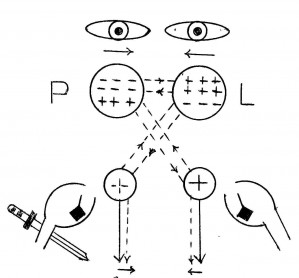 |
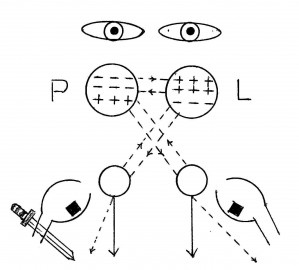 |
| 0 cm 0cm | 10 cm 26 cm |
| a | b |
Fig. 12
Fig. 12 Patient S. B., aged 38, Destruction of the right labyrinth in the period of symmetrical responses in post-rotation tests according to Arslan. No spontaneous nystagmus with eyes closed was found. No positional nystagmus, only in the position on the right side one recorded nystagmoid movements to the right. In the Fitzgerald-Hallpike bi-thermal caloric test after the warm stimulus was found symmetrical nystagmus reactions. In the test with the cold water, an imperceptibly longer nystagmus reaction was found from the left ear. The Torok caloric test revealed a clearly asymmetric reaction after a weak stimulus with the weakness of the reaction from the right ear - the indicator: UP-2,1; UL-1,3. The diagrams present the result of the vestibulo-cerebello-ophthalmic reaction and the vestibulo-cerebellospinal reaction after the stimulus - 280ml-44°C-40" - in the Ruttin test.
a) The first phase of reflexes - the phase of stimulation of the cerebellar hemispheres. Recording in 100" after finishing the administration of the stimulus. No nystagmus. The upper limbs did not change their position.
b) The second phase of reflexes - the phase of inhibition of the cerebellar hemispheres. Recording in 180" from the end of using a caloric stimulus. No nystagmus. The asymmetric abduction of the limbs is bigger on the left side (a bigger inhibition on the right side of the cerebellar hemisphere). The stimuli coming from the stimulated right labyrinth (the side of the damage) get to the stimulated left cerebellar hemisphere, the stimulus coming from the stimulation of the left labyrinth (the healthy side) get to the inhibited right cerebellar hemisphere. The vectors of these powers act in opposite directions and balance out. Therefore, the symmetrical stimulation of both labyrinths was neither capable of causing a vestibulo-cerebello-ophthalmic reactions nor a vestibulo-cerebellospinal reaction. In this instance we deal with the beginning of the process of formation of directional predominance to the right. It is evidenced by the asymmetric reaction after a weak stimulus in the Torok test, the recording of nystagmoid movements to the right in the positional test on the right side, and the vestibulo-cerebellospinal reaction in the second phase of reflexes (the inhibitory phase of the cerebellar hemispheres). Because the right cerebellar hemisphere had already been found before in the constant inhibitory phase, therefore in the second phase (the inhibitory phase) a bigger abduction of the left upper limb was obtained. Personally, I had not encountered earlier the utilization of the assessment of the second phase of reflexes (the inhibitory phase of the cerebellar hemispheres) in the assessment of vestibular habituation personally. In order to recognize this problem closer I will present now the phenomenon of habituation in a patient with the unilateral canal paralysis. I will present the discussion of this phenomenon based on the original figure nr 13 which I presented in the habilitation lecture.
.
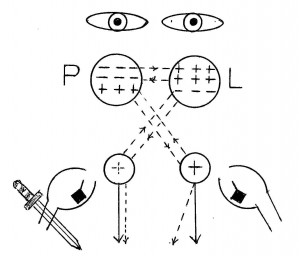 |
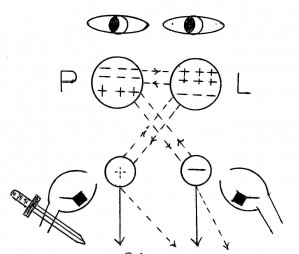 |
| 0 cm 9 cm | 20 cm 10 cm |
| a | b |
Fig.13
Fig. 13 Patient R.B., aged 27. Loss of the function of the right labyrinth. With eyes closed spontaneous nystagmus to the right is recorded. The Torok caloric test - no reactions from the right labyrinth. In the left ear the indicator - 1.2. In the Fitzgerald-Hallpike test only the reaction from the left ear to a cold stimulus was obtained. The diagram presents the results of the reaction obtained in the Ruttin test, recorded in 180" from the end of using the caloric stimulus.
a) 280ml - 44°C - 40". No nystagmus after the warm stimulus. Vestibulo-cerebellospinal reflexes only from the left upper limb (adduction of the left upper limb).
b) 280ml - 20°C - 40". A very long and lively nystagmus reaction to the right (about 3 minutes). Vestibulo-cerebellospinal asymmetric reflexes, bigger in the upper limb on the side of the damaged labyrinth. Here we deal with canal paralysis on the right side and formation of the directional predominance to the right as a result of habituation (the present spontaneous nystagmus to the right). After using a symmetrical warm stimulus, the bioelectric reaction could be released only from the left labyrinth. The stimulation from the left labyrinth was transmitted to the strongly inhibited right cerebellar hemisphere, thanks to which the stimulus was strongly inhibited. Also, the positive resting tension formed as a result of habituation in the right vestibular nuclei complex caused the drift of the bioelectric activity which arose after the warm stimulus from the left ear. Therefore, the stimulus coming from the left labyrinth was not capable of causing a nystagmus reaction to the left, but it was capable of causing a vestibulo-cerebellospinal reflex on the left side, because these reflexes have lower thresholds of excitability. The right upper limb remained still, its abduction to the right is prevented by the stimulated left cerebellar hemisphere. With the cold stimulus a very long nystagmus reaction to the right was obtained because the stimulus from the left labyrinth causes the inhibition of the right cerebellar hemisphere, which was already inhibited earlier as a result of habituation. Therefore, this stimulus is strengthened and the vector of the power from the inhibition of the right cerebellar hemisphere and the vector of the resting power from the left cerebellar hemisphere, stimulated earlier as a result of habituation, act in unison to the right. Therefore the arisen long nystagmus reaction to the right and deviation of both upper limbs to the left. Why did the asymmetric deviation of limbs to the left appear?. This phenomenon can be explained by the fact that habituation resulted in an enlarged tension of the right vestibular function (the vestibular nuclei complex on the right side and the left cerebellar hemisphere). On the other hand, one can take into consideration a big inhibition of the right cerebellar hemisphere in the habituation process and a small volume of its further inhibition with a cold stimulus. In the case of a very strong cold stimulus, one can obtain a weaker vestibulo-cerebellospinal reaction than after a weaker stimulus, as it occurs in the phenomenon of vestibular decruitment in reference to the vestibulo-cerebello-ophthalmic reflex (a low indicator in the left ear). In order to explain the habituation process in more detail I will present another case, which will be discussed based on fig. 3.
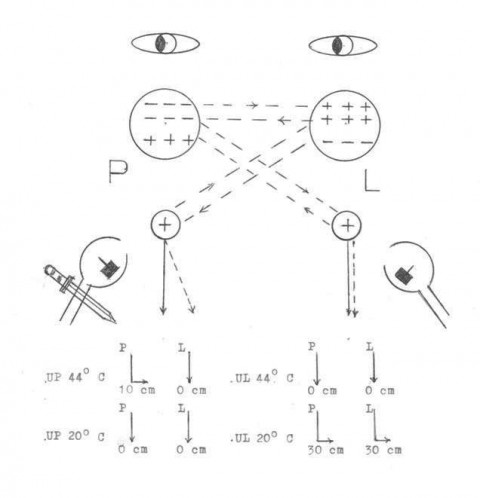
Fig. 3
Fig. 3. Patient S.M., aged 47. The destruction of the right labyrinth within the period of the performed habituation. In the picture one marked the state of spontaneous vestibulo-cerebello-ophthalmic reflexes (nystagmus to the right in the position on the right side) and vestibulo-cerebellospinal reflexes (the result of the Nakiela dynamic test).
The Unterberger test found a rotation to the left. The Nakiela dynamic test found a rotation to the left with the right lower limb moved forward and the lack of rotation with the left lower limb moved forward. No spontaneous nystagmus with eyes closed was found. The positional tests in the position on the back recorded nystagmoid movements to the right. In the position on the right side spontaneous nystagmus to the right was recorded (that is towards the floor, like in the destruction of the right cerebellar hemisphere). In the post-rotary reaction in the kinetic test according to Arslan no nystagmus reaction to the left was obtained. The Torok caloric test, after a weak stimulus, found a distinct asymmetry with the weakness of the reaction on the right side. The indicator: UP-3,5; UL-1,0. The calorization in the bicaloric test was performed with the use of waters with the temperature of 44°C and 20°C, in the quantity of 100ml, poured in within 20 seconds. In the assessment of the nystagmus reaction one used the durations of the nystagmus reaction:
P44°C=100"; L44°C=no reaction; P20°C=120"; L20°C=140".
After the assessment of the bicaloric test one found a real crossed directional predominance of nystagmus to the right, associated with canal paresis on the left side.
After using caloric stimulus one also evaluated vestibulo-cerebellospinal reflexes at the 60th second after the administration of the stimulus was finished. After the warm stimulus from the right ear one found adduction of the right upper limb to the left by 10 cm, the left limb remained in the same position. When using hot water to the left ear no vestibulo-cerebellospinal reaction was obtained, the limbs remained in the same marking time test. After this stimulus no nystagmus reaction one was obtained, either. After using the cold stimulus to the right ear no deviation of the upper limbs was obtained despite a clear nystagmus reaction. After calorization of the left ear with a cold stimulus one obtained a deviation of both upper limbs to the left by 30 cm. In this instance habituation arose as a result of the asymmetric resting activity of the labyrinths, bigger on the side of the left labyrinth. A similar model of habituation in a healthy person can be obtained by using repeated stimulations of the left ear with hot water. Returning to the presented example, it is clearly visible that after using water with the temperature of 44°C to the left ear neither vestibulo-cerebello-ophthalmic reaction nor any vestibulo-cerebellospinal reaction were obtained. IT IS SO BECAUSE THE RIGHT CEREBELLAR HEMISPHERE IS IN A STATE OF CONSIDERABLE INHIBITION, AND THE LEFT CEREBELLAR HEMISPHERE IS IN A STATE OF CONSIDERABLE STIMULATION AS A RESULT OF THE ACCOMPLISHED HABITUATION. In this instance we say that the performed habituation is specific as regards the direction of nystagmus reactions to the left and the vestibulo-cerebellospinal reaction to the right. However, after using hot water to the right ear we obtained a clear nystagmus reaction to the right and adduction of the right upper limb to the left. The result of this reaction after the warm stimulus from the right ear is compatible with the result of the Nakiela dynamic test. The cold stimulus used in the right ear did not cause a deviation of the upper limbs to the right, either. SUCH A REACTION IS NOT PERMITTED BY THE LEFT CEREBELLAR HEMISPHERE IN THE STATE OF STIMULATION AND THE RIGHT CEREBELLAR HEMISPHERE IN THE STATE OF INHIBITION. Based on the obtained results, it is clearly visible that after none of the stimuli being used no deviation of the upper limbs to the right was obtained. We can therefore say that the directional habituation of the vestibulo-cerebellospinal reflexes was obtained. This example can explain the observations made by Barany (9). In his lecture the researcher mentioned that in his own research he had found cases in which the reaction of the limbs did not appear only in one direction, towards the ill side of the cerebellar hemisphere. In the described case the right cerebellar hemisphere was in a state of high inhibition. Using the Ruttin tests with cold water in this case will cause the abduction of the left upper limb to the left, as it is in the destruction of the right cerebellar hemisphere. The presented material irrefutably shows that the mechanism of the directional predominance is closely connected with the vestibular habituation. It must also be mentioned that investigation into the equilibrium system without the assessment of the vestibulo-cerebellospinal reflexes becomes imperfect.
REFERENCES
1. Henriksson N.G., Kohut R., Fernandez C.: Studies on habituation of vestibular reflexes. Acta Oto-laryng. 1961, 53, 333-349.
2. Bień S.: Vestibular habituation. The textbook: Clinical Otoneurology edited by G. Janczewski. Warsaw 1986. PZWL.
3. Nakiela J.: The vestibulo-cerebellar system according to the latest investigations and interpretation of the author. Lecture at the examination for the degree of assistant professor. ŁódĽ, Military Medical Academy. 1990.
4.Llinas R., Walton K.: Vestibular compensation: A disturbend properity of the control nervous system. W: Integration in the nervous system (red.: Asanuma H., Wilson V.J.). Jgaku -Shoin, Tokyo 1979, 145.
5. Lindvall H.F.: Vertigo and nystagmus responses to caloric stimuli repeated at short and long intervals. Acta Oto-Laryng. 1961, 53, 507-517.
6. Frenzl H.: Spontan - und Provokations - Nystagmus als Krankheitssymptom, Springer, Berlin. 1955.
7. Fluur E.: Vestibular compensation after labyrinthine destruction. Acta Oto-Laryng. 1960, 52, 367-375.
8. Ukleja Z.: Compensation. In: Clinical Otoneurology edited by Zbigniew Bochenek. PZWL. 1977.
9. Barany R.: Some new methods for functional testing of the vestibular apparatus and the cerebellum. Nobel Lecture, September 11, 1916.